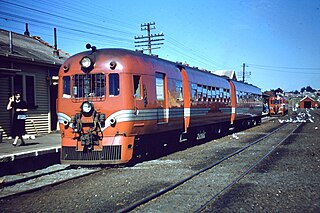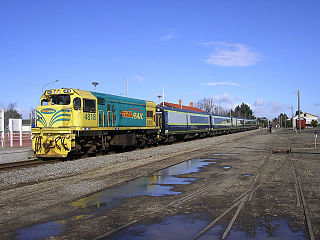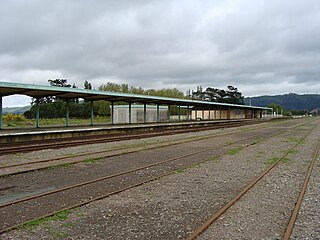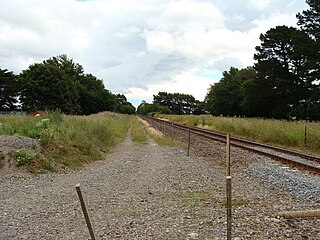Related Research Articles

The NZR RM class 88-seaters were a class of railcar used in New Zealand. New Zealand Government Railways (NZR) classified them as RM , the notation used for all railcars, numbering the 35 sets from RM100 to RM134. They were the most numerous railcars in NZR service. Their purchase and introduction saw the demise of steam-hauled provincial passenger trains and mixed trains, and was part of a deliberate effort to modernise NZR passenger services at a time of increasing competition from private motor vehicles. Being diesel powered and lighter the railcars were less expensive to operate and able to maintain quicker timetables, although became plagued with mechanical and electrical problems, with a number of the class eventually being turned into depowered locomotive-hauled carriages and reclassified as the AC class "Grassgrubs".

The Wairarapa Line is a secondary railway line in the south-east of the North Island of New Zealand. The line runs for 172 kilometres (107 mi), connects the capital city Wellington with the Palmerston North - Gisborne Line at Woodville, via Lower Hutt, Upper Hutt and Masterton.

The NZR RM class Wairarapa railcar was a class of railcars on New Zealand's national rail network. They entered service in 1936 and were classified RM like all other classes of railcars in New Zealand; they came to be known as the "Wairarapa" class as they were designed to operate over the famous Rimutaka Incline to the Wairarapa region on the Wairarapa Line. They also acquired the nickname of "tin hares" in New Zealand railfan jargon. The first two to be introduced re-used the numbers RM 4 and RM 5 that had previously been used by the withdrawn experimental Model T Ford railcars. The class consisted of six passenger railcars and one passenger-freight railcar. It is often described incorrectly as a class of six railcars.

The Wairarapa Connection is a New Zealand interurban commuter rail service along the Wairarapa Line between Masterton, the largest town in the Wairarapa, and Wellington. It is operated by Wellington suburban operator Transdev under contract from the Greater Wellington Regional Council. It is a diesel-hauled carriage service, introduced by the New Zealand Railways Department in 1964 after passenger demand between Masterton to Wellington exceeded the capacity of the diesel railcars then used.

The Napier Express was a passenger express train operated by the New Zealand Railways Department initially between Napier and Palmerston North and later between Napier and Wellington. It ran from 1891 until 1954.
The New Plymouth Express was a passenger express train operated by the New Zealand Railways Department (NZR) between Wellington and New Plymouth. It ran from 1886 until 1955 and was sometimes known as the New Plymouth Mail due to the Railway Travelling Post Office carriages included in its consist. The Express was notable amongst NZR's provincial expresses as being both the first and, until the commencement of the Gisborne Express in 1942, the longest in distance travelled.

Mangatainoka is a small settlement in the Tararua District of New Zealand's North Island. It is located on the banks of the Mangatainoka River, 5 km (3.1 mi) north of Pahiatua.

The Hutt Valley Line is the electrified train service operated by Transdev Wellington on behalf of Metlink on the section of the Wairarapa Line railway between Wellington and Upper Hutt, New Zealand.

Masterton railway station is a single-platform, urban railway station serving the town of Masterton in New Zealand's Wairarapa district. Located at the end of Perry Street, it is one of three stations in Masterton, the others being Renall Street and Solway. Masterton station is the terminus for Wairarapa Connection passenger services on Metlink's Wairarapa Line from and to Wellington. The average journey time to Wellington is one hour and forty-three minutes.
The Palmerston North–Gisborne Line (PNGL) is a secondary main line railway in the North Island of New Zealand. It branches from the North Island Main Trunk at Palmerston North and runs east through the Manawatū Gorge to Woodville, where it meets the Wairarapa Line, and then proceeds to Hastings and Napier in Hawke's Bay before following the coast north to Gisborne. Construction began in 1872, but the entire line was not completed until 1942. The line crosses the runway of Gisborne Airport, one of the world's only railways to do so since Pakistan's Khyber Pass Railway closed.

Woodville railway station is the northern terminus of the Wairarapa Line and is located at the junction with the Palmerston North–Gisborne Line in the small Tararua town of Woodville, 27 km (17 mi) east of Palmerston North in New Zealand's North Island.

Pahiatua railway station is on the Wairarapa Line in New Zealand's North Island. It was opened in May 1897, shortly before the line was opened to Woodville in December of that year. The station is located in Mangamutu, 1.7 kilometres (1.1 mi) west of Pahiatua, in contrast to the original plans for the railway line to run through the town.

Fernside railway station was a flag station that served the small rural community of Fernside, north-east of Featherston in New Zealand’s North Island. It was located on the Wairarapa Line near the southern bank of the Tauherenikau River. The station opened to traffic in 1880 and closed nearly a century later in 1975.

Dalefield railway station was a station on the Wairarapa Line that served the small rural community of Dalefield, just south of Carterton in the Wairarapa region of New Zealand’s North Island. It survived for just over a century from when the line opened in 1880 until it was closed in 1981.

Clareville railway station was a flag station serving the small settlement of Clareville, north of Carterton in the Wairarapa region of New Zealand's North Island. It survived for nine decades from when it opened in 1880 until closure to all traffic in 1970.

Mangamahoe railway station served the small rural community of Mangamahoe in the Wairarapa region of New Zealand’s North Island. It was located on the Wairarapa Line between the stations of Mauriceville and Eketahuna with vehicular access from Station Road. It is the northernmost station site on the Wairarapa Line within the jurisdiction of the Greater Wellington Regional Council before the line passes into territory governed by Horizons Regional Council.

Mauriceville railway station was a rural railway station that served the small village of Mauriceville in the Wairarapa region of New Zealand’s North Island. It was located on the Wairarapa Line between the stations of Kopuaranga and Mangamahoe with direct vehicular access from Opaki Kaiparoro Road.

Opaki railway station served the small rural village of Opaki, 6 km (3.7 mi) north of Masterton, in the Wairarapa region of New Zealand’s North Island. It was located on the Wairarapa Line between the stations of Masterton and Kopuaranga with vehicular access from Wingate Road.

Eketahuna railway station was a station on the Wairarapa Line, a railway line that runs through the Wairarapa region of New Zealand's North Island. Located between the stations of Mangamahoe and Newman, it served the small southern Tararua town of Eketahuna and was one of the few attended stations on the northern section of the line.

Kopuaranga railway station was a flag station that served the small rural settlement of Kōpuaranga, 12½ km north of Masterton, in the Wairarapa region of New Zealand’s North Island. It was located on the Wairarapa Line between the stations of Opaki and Mauriceville. From its opening in 1886 it handled both passenger and freight traffic for 97 years until closure in 1983.
References
- ↑ Churchman & Hurst 2001, pp. 161, 166.
- 1 2 Mahoney 1987, p. 83.
- ↑ Churchman & Hurst 2001, p. 81.
- 1 2 Mahoney 1987, p. 81.
- 1 2 3 Churchman & Hurst 2001, p. 161.
- ↑ Mahoney 1987, p. 86.
- ↑ Mahoney 1987, p. 85.